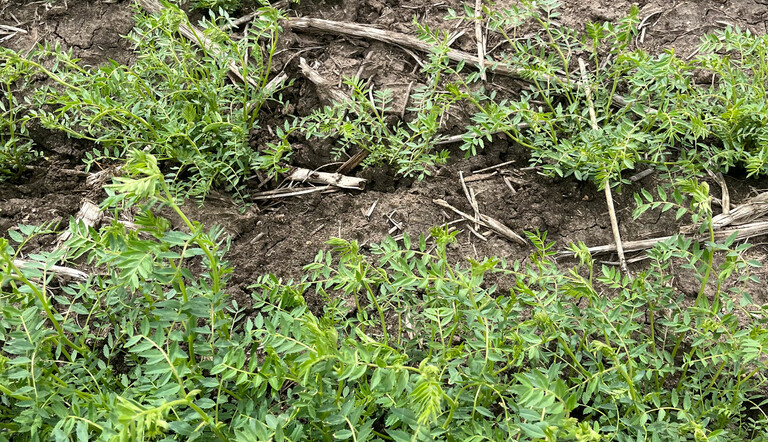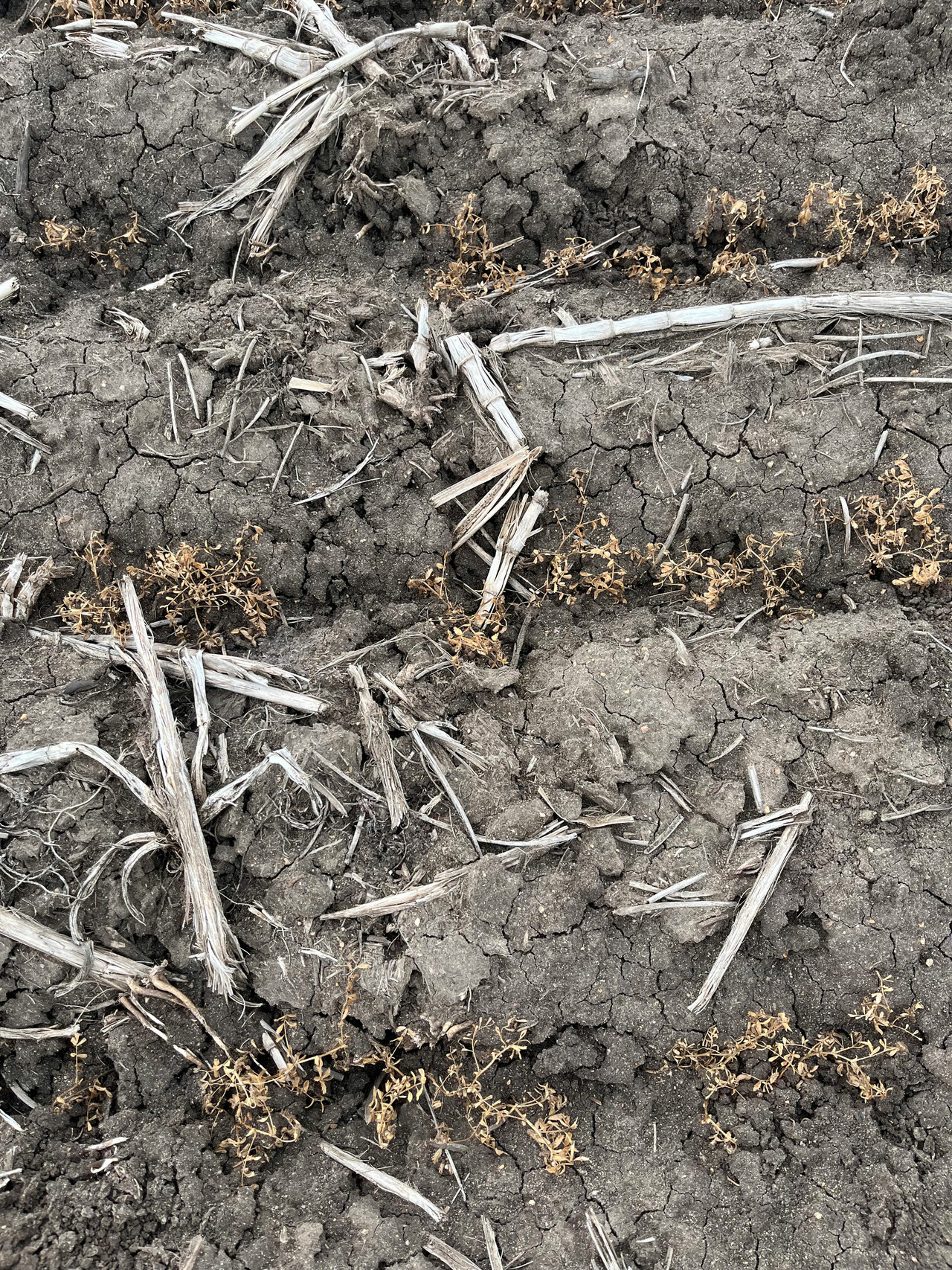
New post-emergent herbicide tank-mix options welcomed by Northern growers

Chickpeas pictured in the untreated area of the Grindstone herbicide trial.
THE ability to cost-effectively mix a selected rate of aminopyralid broadleaf weed herbicide with other cereal post-emergent herbicide partners has put a smile on the face of northern croppers over recent years and it appears it will only widen this year.
The launch of Grindstone® by ADAMA Australia in 2023 introduced a solo formulation of aminopyralid, which previously had only been available in co-formulations with other herbicides.
Jim O’Connor, Market Development Manager with ADAMA Australia in Southern Queensland, said growers have used Grindstone to create their own post-emergent brews particularly with picloram and MCPA herbicides, and with metsulfuron or fluroxypyr herbicides also added to tank mixes in some cases.
“It has allowed flexibility with their post-emergent tank mixes, they could avoid using metsulfuron when using the aminopyralid in Grindstone, and they could dial the aminopyralid rate up or down to suit their situation,” Jim said.
He said many growers have taken the opportunity to use a higher-than-normal rate of aminopyralid in their tank mixes to improve in-crop weed control and achieve good residual control into fallows and through to the following season.
“They have applied it in mixes at the early tillering stage of crops and looked to suppress weeds through to the next growing season.”
“The higher rate of aminopyralid makes the tank mixes better and gives that extra residual punch, resulting in less weeds and cleaner paddocks.
“These mixes have been particularly good against sowthistle and fleabane.”
Picture shows the control of the chickpeas from an application of Grindstone at 32 mL/ha in a tank-mix with Flagship 400 at 265 mL/ha.
The ability to select the rate of aminopyralid and other herbicides in tank mixes also allows greater re-cropping flexibility.
Jim said the cost-effectiveness of using Grindstone with a range of tank-mix partners was another major attraction for growers and they also used the mixes to target climbing buckwheat, wireweed and volunteer pulses, as well as prickly lettuce in southern areas.
Grindstone is compatible with a broad range of grass and broadleaf herbicides and doesn’t compromise efficacy of commonly used selective grass herbicides in cereal crops.
Its unique soluble liquid formulation also is user-friendly and easier to handle than existing granular products.
“The release of Grindstone has certainly been well received and supported by growers. Its use has exceeded our expectations and we are prepared for stronger interest in the coming season,” Jim said.
While predominantly used to assist post-emergent and residual control of broadleaf weeds in winter cereals, Grindstone also enhances partner herbicide efficacy of woody weeds including African boxthorn, blackberry, lantana, sweet briar and wattle in fallows, grass pastures and non-crop situations, as well as cereals.
Jim said, again, the ability to adjust rates of metsulfuron and picloram herbicides with Grindstone was a benefit for these situations, plus using it in tank mixes with herbicides containing triclopyr.
Jim O’Connor, Market Development Manager with ADAMA Australia in Southern Queensland, says the introduction of Grindstone herbicide, offering a solo formulation of aminopyralid, has allowed growers the flexibility to create their own post-emergent herbicide brews for controlling broadleaf weeds in cereals.
Ed Offner, agricultural consultant with Michael Castor and Associates (MCA) Agronomy, in Queensland’s Western Downs region, said the use of ADAMA Grindstone herbicide had resulted in cleaner fallows following cereals, extending residual weed control into spring and summer.
He said it also had increased farmers’ recropping flexibility and reduced the reliance on phenoxy herbicide applications in cotton growing regions.
Ed is based at Chinchilla and assists growers in a region from Taroom to Westmar and from Dalby out to Roma, but particularly around Condamine and Meandarra.
“We have used Grindstone in wheat and barley for its strong residual control, especially of fleabane, helping to keep our early summer fallows clean,” Ed said.
“Grindstone has been an effective additive to our standard in-crop, knockdown herbicide mixtures, particularly adding to the control of milk thistle and climbing buckwheat (black bindweed).
“Previously, metsulfuron was used in a co-formulation with aminopyralid, which has been the standard herbicide for these applications, whereas now growers are looking at picloram plus aminopyralid for better results and greater flexibility. If growers want to go a bit later, they might use MCPA with Grindstone and still get the residual benefit with the aminopyralid. This extra timing has especially helped larger growers and still delivered good results.
“Ally and other metsulfuron products also restricted following crop options, so the use of Grindstone has definitely opened up recropping flexibility.”
He said Grindstone made aminopyralid available by itself and growers could decide how much to use, customising the rate and tank-mix partners based on the target weeds and desired results.
The introduction of Grindstone also has reduced phenoxy herbicide applications and related concerns in sensitive cotton areas.
“With Grindstone helping to lower weed populations, growers are able to look at other herbicide options in these situations, plus the use of optical spot sprayers,” Ed said.
Ed Offner, agricultural consultant with Michael Castor and Associates (MCA) Agronomy in Queensland’s Western Downs region, says ADAMA Grindstone herbicide has resulted in cleaner fallows following cereals, extending residual weed control into spring and summer
St George-based agricultural consultant, Phillip Lockwood, said ADAMA Grindstone herbicide was being targeted for use in winter cereals to help achieve extended residual control of problem weeds leading into harvest, and thereby also helping limit hormone herbicide applications over the summer fallow period in sensitive areas.
Phillip’s business, Meremley Agricultural Services, supports winter cereal and legume growers, as well as irrigated cotton areas, in the Western Queensland region.
He said sowthistle and fleabane can germinate year-round and be buoyed by summer storms, while sowthistle populations also were showing increasing resistance to glyphosate herbicide.
The popular use of 50-centimetre wide row spacings in winter dryland farming systems, which has achieved good yield results under the conditions typically experienced in the region, has come at the expense of crop competition. This has resulted in a greater abundance of weeds later in cropping cycles, if not addressed with an appropriate herbicide selection.
Phillip said in winter cereals, picloram, MCPA, aminopyralid and fluroxypyr post-emergent herbicides had all been used in tank mixes against problem weeds in the past, whereas Grindstone (aminopyralid) combined with MCPA and picloram had now become “the go to brew”.
“We’ve also used Grindstone tank mixes in oats, and we’ve added some metsulfuron into the mix in wheat and barley for improved control of medic and New Zealand spinach,” Phillip said.
“It’s definitely improved the length of the residual control and paddocks are certainly ending up cleaner – it’s been noticeable.”
Queensland agricultural consultant Phillip Lockwood, St George, says applications of Grindstone herbicide are definitely improving the length of residual control of problem weeds, resulting in cleaner paddocks.
For further information on using the herbicide tank-mix partner, Grindstone, growers can contact their local ADAMA Australia representative or visit ADAMA.com.
Media Contact:
Holly Hartley | Marketing Campaign Manager | D: 0473 210 903 |



